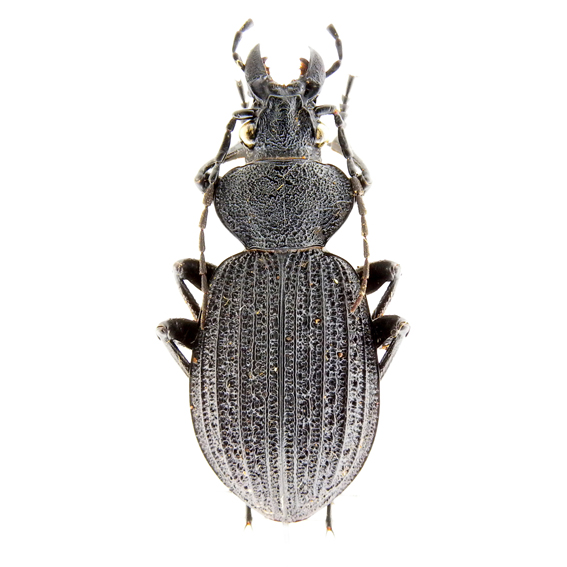Calosoma (Carabops) rugolosum Beheim & Breuning, 1943
Calosoma (Carabomorphus) rugolosum Beheim & Breuning, 1943: 21 (type locality: Tangajika territorium, Tanga); holotype ♂ in Naturalis Biodiversity Centre, Leiden (de Boer, 2002: 102)
Carabops rugolosus sensu Rougemont, 1976: 271
Carabomorphus rugolosum Lorenz, 2005: 70
Length 20-24 mm. C. rugolosum has been described (Beheim & Breuning, 1943) on one single specimen doubtfully cited from Tanzania (the town of Tanga, on the coast, is certainly an inaccurate locality). The authors considered that more likely it should come from Ethiopia, and Rougemont (1976:272) thought that he could identify as C. rugolosum those Ethiopian specimens with eterodiname elytral sculpture, that instead Breuning (1928: 130), in his description of C. aetiopicum, had already attributed to the complex of the forms of this species. Finally, C. rugolosum was subsequently found in many specimens in northern Tanzania (Manyara region).
In the original description it is compared with C. aetiopicum to which it is closely related by admission of the authors themselves. In particular, C. rugolosum is superficially similar to the forms of C. aetiopicum with sculpture of the elytra heterodynamic (Carabops rugolosus sensu Rougemont), but both this sculpture and the microsculpture of the head and pronotum and that of the lower part of the abdomen present even more evoluted characteristics.
In fact C. rugolosum has head and pronotum strongly wrinkled and with a dense and thick punctuation. The sculpture of its elytra is rather raised and is characterized by the primary intervals consisting in tubercles, the secondary ones in continuous ribs, and the tertiary ones replaced by transverse roughness and not by granules as it happens in the forms of C. aetiopicum with sculpture of the elytra more evoluted towards the heterodynamic model.
Finally, as regards the body shape, C. rugolosum presents a variability similar to that observed in C. aetiopicum. The typical specimen has a somewhat narrower pronotum ed elongated elytra, while in the series of specimens of Manyara the pronotum is wider and the elytra are a little more stocky. However the silhouette of the pronotum remains fairly constant having the maximum width just at the middle and being posteriorly narrowed, uniformely rounded, not angulose and never sinuata. The same applies to the elytra, constantly enlarged in their posterior third.
Examined specimens
Tanzania: Tangajika territorium, Tanga (holotype of rugolosum NBC); Manyara region, Bonga village near Babati (AVT, EM, EO, SB)
Notes Brachypterous, Diurnal and presumably nocturnal. There are about a dozen specimens scattered in various collections. The more recent collecting, took place in a forest, at an altitude of 1,500 m. The individuals were found in activity on the ground after a rainfall in November and December, at the beginning of the rainy season.
 Tangajika territorium, Tanga holotype of Calosoma (Carabomorphus) rugolosum (coll. Naturalis Biodiversity Centre, Leiden) (photo by the courtesy of Alberto Zilli) |
 Tanzania, Manyara region, Bonga village near Babati XI.92, Werner lgt. (coll. Vigna Taglianti) |
 Tanzania, Manyara region, Bonga village near Babati XI.92, Werner lgt. (coll. Vigna Taglianti) |